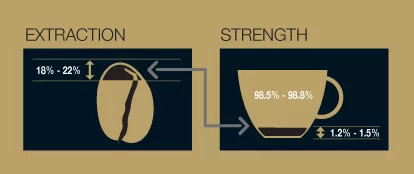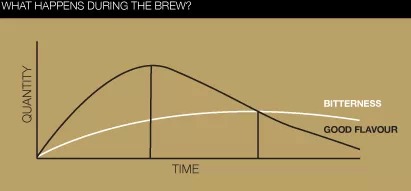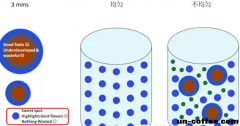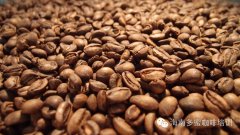Those things about coffee extraction espresso extraction and correction
(1) EBF
Today, with the increasing concern of the boutique coffee industry, as an objective and real data, the impact of coffee extraction rate on the performance of the cup has been recognized by most knowledge-based baritsa. Under this premise, it means that we can combine the variables that affect the extraction rate and analyze in depth how to achieve appropriate extraction by modifying the extraction rate.

1. Reasonable range
For a cup of erpresso, 30ml in 25 seconds was once the golden rule that everyone kept in mind. However, in the continuous exploration and attempt of boutique coffee, a group of reformed knowledge-based barista appeared among coffee people, who almost completely abandoned the restrictions and interpreted espresso with their own understanding of coffee.

The Golden Cup Rule is the most authoritative industry standard at present. This standard is widely recognized precisely because it is easy to understand and apply. A coffee extraction rate of 18% to 22% can lead to the aroma and taste of coffee. Corresponding to different proportions of water, it can satisfy the taste preferences of different people in terms of concentration.

How different are the so-called taste preferences? The two major guilds said: tds=1.15%~1.35% (SCAA), 1.2% and 1.45% (SCAE).
There is really no restriction on the concentration range of espresso in the Golden Cup rule, as long as the extraction rate is appropriate, the concentration is up to me!
2 、 EBF
EBF= Espresso Brew Formula, that is, the ratio of coffee powder to coffee liquid.
At present, the extraction principle of all Italian coffee equipment on the market is to carry out through-type extraction under pressure. In pass-through extraction, the concentration decreases with the increase of extraction time (extraction rate). Is it a bit of a mouthful here? Then imagine that if we want to maximize the extraction rate of a pressed powder to 30%, all we can do is to keep extracting until the water coming out of the handle is pure water. So, at this time, is the coffee concentration in the cup lower than the extraction rate of only 20%? On the other hand, a cup of espresso with relatively high concentration will have a relatively low extraction rate.

Therefore, our colleagues have done a very useful data collation, probably summed up the 'typical' espresso powder, coffee liquid ratio, both ebf50%. For example: powder 18g: liquid 36g. Pay attention! It is typical of typical, not standard standard.
3. EBF correction
In the reasonable extraction range of espresso-18%-22%, to ensure the complete embodiment of aroma and taste, the typical espresso,ebf can be controlled at about 50%. If it is atypical espresso, it depends on personal preference and equipment performance!
In the work, EBF can be corrected by "grinding coarse and fine grinding", "adding some powder, reducing powder", "more extraction point, less extraction point", "more water release, less water release".
EBF can help you decide when to grind, when to adjust the amount of powder, and when to control the flow of coffee.

EBF < 40% = low concentration, high extraction rate, bitter and light (e.g. 18g powder, 45g coffee liquid, adjust taste direction)
EBF > 60% = high concentration, low extraction rate, high acid concentration (e.g. 18g powder, 30g coffee liquid, adjust flavor direction)
(2) Grinding
The thickness of the grinding determines the contact area between the coffee and the book, thus effectively changing the coffee extraction rate. From the perspective of barista, it can be understood as a flavor correction method in the process of coffee extraction:
Under the same conditions, relatively fine coffee particles are easier to be extracted than relatively coarse coffee particles.

The horizontal axis in the picture can be understood as time, and the longitudinal axis is the particle size. If brown is regarded as insufficient extraction, green is the transition of extraction, and blue is the ideal extraction.
Just imagine, boiled potatoes in a pot of boiling water, the whole potatoes, potato pieces, shredded potatoes, must be cooked first. Of course, if a whole potato is boiled, the longer it takes to cook, the more thoroughly it will be cooked. From the point of view of coffee, 10g coffee is put into 200g water, after the same time, the appropriate particle size can bring the appropriate extraction rate. Similarly, when the particle size is the same, the extraction rate is related to the extraction time.

In fact, grinding, as a flavor correction method, is easy to master in immersion extraction. However, in pass-through extraction, many barista make mistakes in correction because of the relationship between time and extraction quantity.
For example, a store sets the extraction-18g in;36g out-based on the ebf 50% of a typical espresso. The grinding scale corresponds to the usual 28 seconds. Raise your glass and drink. Savor it carefully. The barista thinks that this cup of espresso can taste better, but the flavor may only develop to the second stage, the extraction is insufficient!
First of all: fine grinding, or 18g in,26s 27s 28s. . It will be more than 30 seconds, and the amount of extraction is less than 36g! The river was cut off in time to save the extraction time. Raise your glass and drink. Savor it carefully. Not as good as the first one! Combined with the trend of extraction time, it is considered that the extraction is excessive!

Barista, who understands the conversion of the extraction rate, may have seen the problem-such adjustments and conclusions are completely meaningless! Because in the case of no concentration meter, we can not get the tds reading, nor can we calculate the extraction rate! Excessive extraction and insufficient extraction can only be said to be subjective and completely unconvincing.
Let's help the barista together, or 18g coffee. When the grinding scale is changed, the relationship between the two variables we will get is
1. Ebf 50%, the extraction time is prolonged.
2. The extraction time remained unchanged for 28 seconds, and the ebf value increased.
In pass extraction, the change of ebf will also correspond to the change of extraction rate. Therefore, when we decide to modify the extraction rate by adjusting grinding, ebf can not be changed. Otherwise, the extraction result will become uncontrollable. After understanding this truth, my mother no longer has to worry about the extraction time of the boss. Grind it with fine grinding and continue with 18g in,36g out. Combined with the previous extraction results, finally find the performance you want in the cup.
At this point, the conclusion of grinding modified extraction rate has gradually become clear.
With the same amount of extraction, the smaller coffee particles is equivalent to the greater extraction ability of water acting on coffee particles, and the extraction rate will also be increased. It should be noted that while adjusting the grinding, the ebf can not be changed because of the change of extraction time, so that the result is uncontrollable.
Let's continue to look at the essence through the phenomenon. today, with the popularity of more and more high-performance equipment and advanced instruments, as barista, we can not be dominated or even kidnapped by data. When you want to make an espresso, you don't need to buy a high-end device or a densitometer right away, but do as much as you can-make the results manageable.


Important Notice :
前街咖啡 FrontStreet Coffee has moved to new addredd:
FrontStreet Coffee Address: 315,Donghua East Road,GuangZhou
Tel:020 38364473
- Prev

Those things about coffee extraction extraction and extraction equilibrium
The reasonable extraction range was set by ebf, and the extraction results were tested by tds. Combined with the grinding scale and the ratio of gouache to powder to modify the results, it is the quality control system of most knowledge-based barista when making espresso. Under this seemingly rigorous operation process, will there be loopholes? Extraction uniformity is a monitoring blind area which is easy to be ignored. Uniform means to distribute or divide.
- Next

7 Coffee Health Secrets You Didn't Know About Coffee
According to the U.S. Food and Drug Administration (FDA), 80% of adults in the United States consume caffeine daily, and the average intake is about 200 mg per day (equivalent to about two 5-ounce cups of coffee). With this data in mind, it makes sense when we look at the following survey results: Of the 7000-plus people surveyed, most said they would rather
Related
- Beginners will see the "Coffee pull flower" guide!
- What is the difference between ice blog purified milk and ordinary milk coffee?
- Why is the Philippines the largest producer of crops in Liberia?
- For coffee extraction, should the fine powder be retained?
- How does extracted espresso fill pressed powder? How much strength does it take to press the powder?
- How to make jasmine cold extract coffee? Is the jasmine + latte good?
- Will this little toy really make the coffee taste better? How does Lily Drip affect coffee extraction?
- Will the action of slapping the filter cup also affect coffee extraction?
- What's the difference between powder-to-water ratio and powder-to-liquid ratio?
- What is the Ethiopian local species? What does it have to do with Heirloom native species?

